Affiliate links on Android Authority may earn us a commission. Learn more.
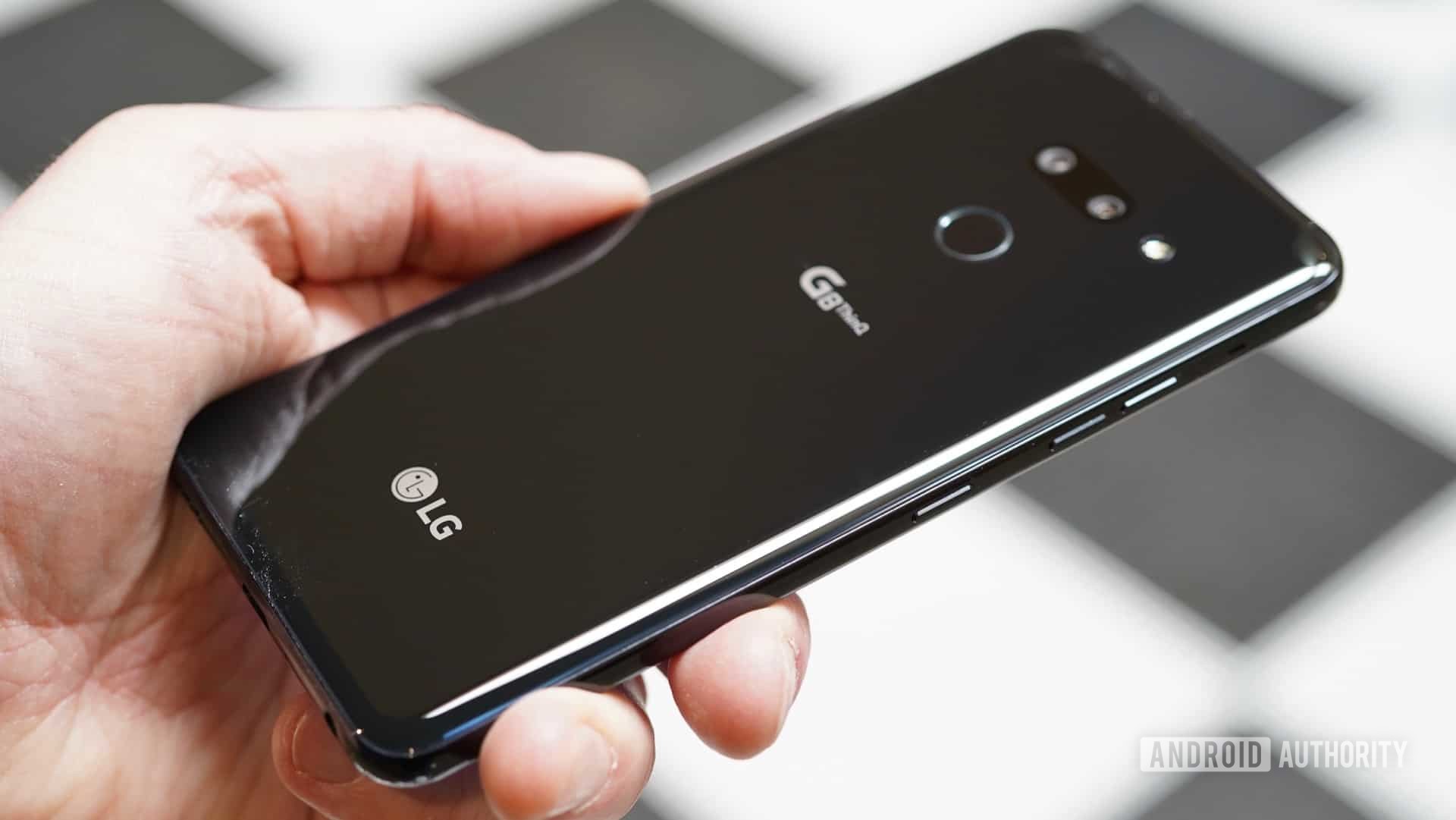
LG G8 ThinQ review: LG chooses to blend in rather than stand out
April 9, 2019
LG G8
What we like
What we don't like
Our scores
LG G8
Using the LG G8 ThinQ made me feel like a failed Jedi or an inept Dr. Strange. LG’s flagship phone touts new hand-based gestures for controlling the phone thanks to its innovative time-of-flight camera. This is the future I want to live in, but it’s not quite the right time yet.
The G8 isn’t all wavy hand gestures. It’s an honest-to-goodness premium device, with the latest specs and a relatively compact and high-quality design. With multiple cameras, more biometrics than James Bond’s Aston Martin, and a Crystal Sound OLED, there’s a lot of promise. Does LG deliver?
LG G8 ThinQ review: The big picture
LG is fighting for its life. The company’s mobile division continues to bleed cash. So much so, in fact, that LG Electronics folded its mobile business into its general consumer electronics business to mask mobile’s (poor) performance. With its phones struggling, each and every device from LG needs to have an impact.
The G8 ThinQ is LG’s smaller flagship for 2019. It competes directly with the Samsung Galaxy S10, Apple iPhone Xs, Google Pixel 3, and HUAWEI P30 Pro. While it checks off most of the boxes in terms of specs and features, it doesn’t necessarily deliver on the emotional component that often drives purchases. This inability to elicit desire is what hurts LG most.
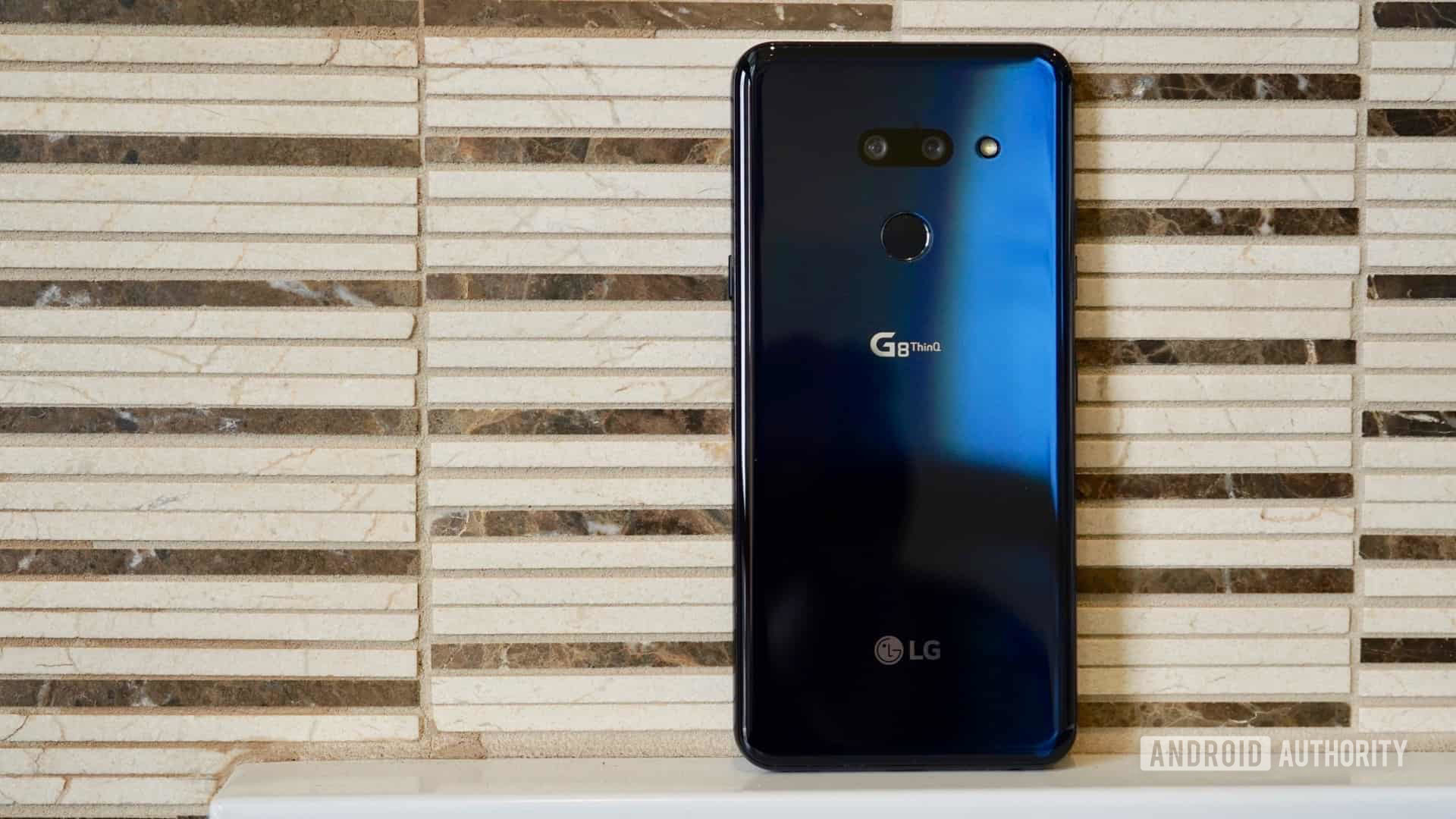
To make up for this shortcoming, LG decided to throw a handful of new technologies at the G8 hoping to make an impression. It worked, but I’m not sure it’s the impression LG wanted.
What’s in the box
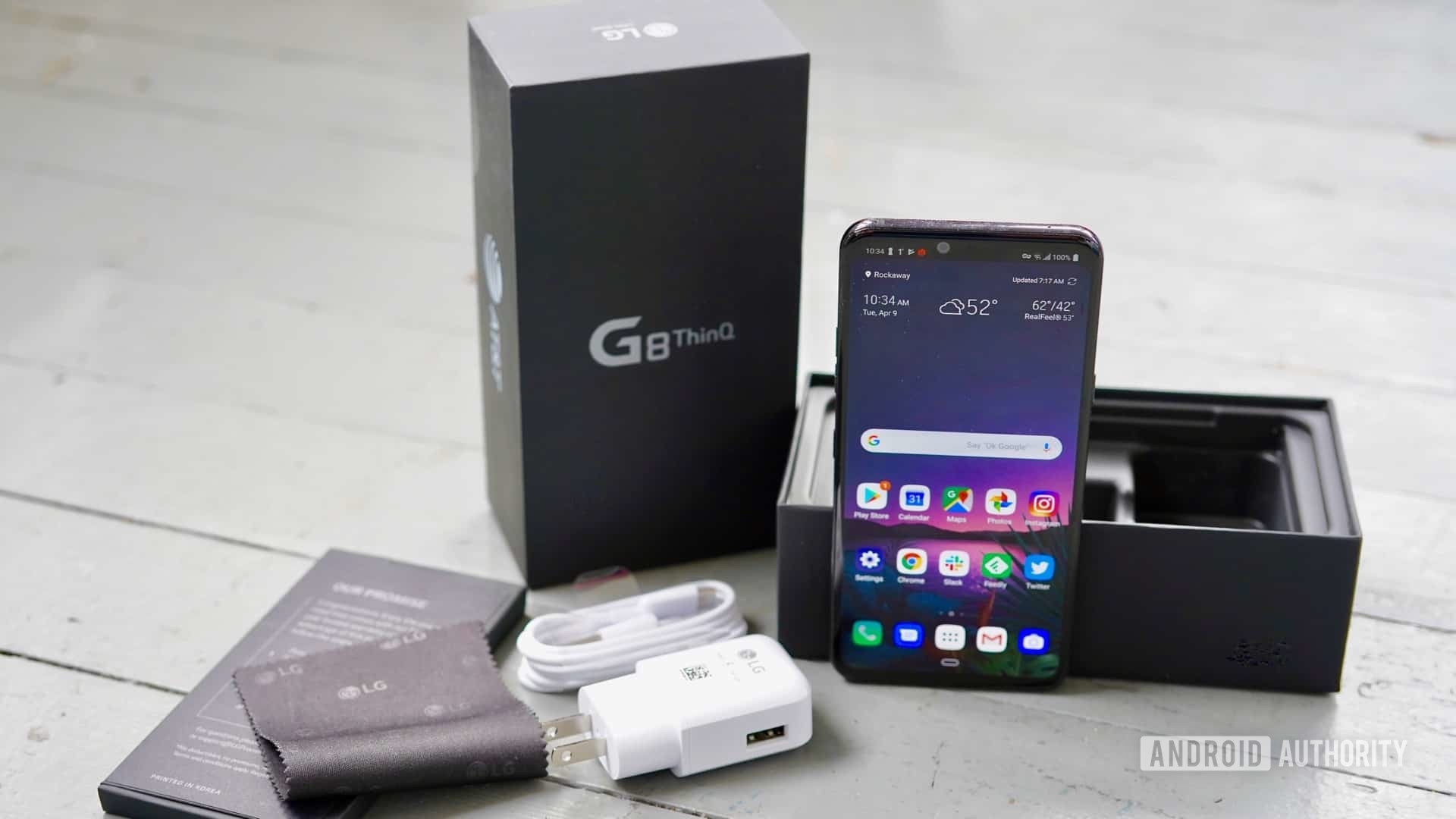
LG ships the G8 ThinQ with the bare minimum. It includes a QuickCharge 3.0 wall plug, a USB charging cable, a SIM tool, and a black polishing cloth. That’s it; no headphones, no basic case or protector, no extra memory card. You’re on your own for that stuff.
Design
- 151.9 x 71.8 x 8.4mm, 167g
- Aluminum frame
- Gorilla Glass 6 front/back
- Fingerprint reader
- Nano SIM / microSD tray
- 3.5mm headphone jack
- IP68
- USB-C
There’s fine, and then there’s fine. Some things are one or the other, and some are both. The LG G8 ThinQ is certainly the former, but I wouldn’t describe it as the latter.
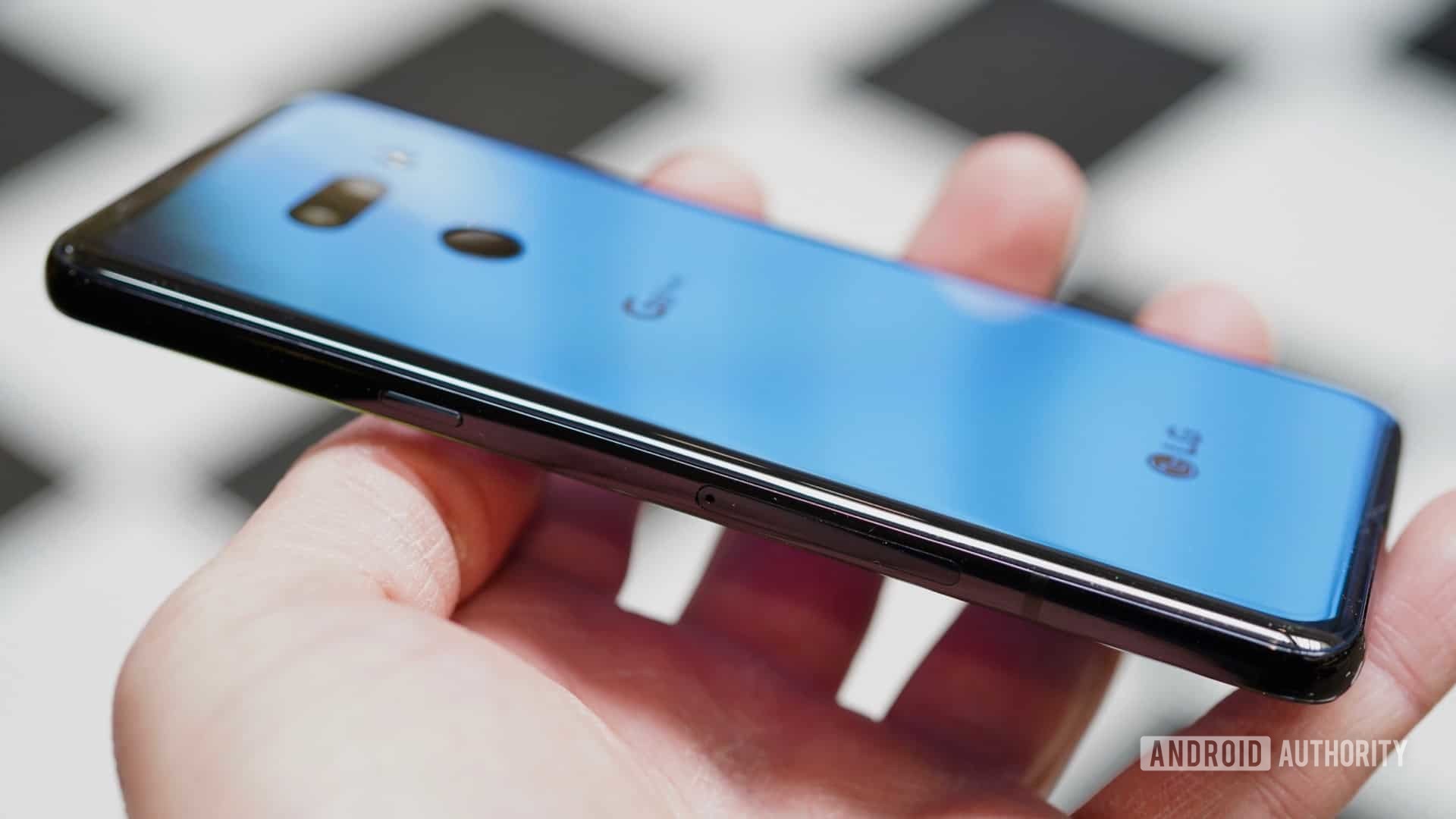
The G8 is a recycled G7 as far as the basic blueprint goes. It’s nigh impossible to tell them apart from a few feet away. Only the shape of the camera module sets them apart visually. LG calls the stark glass-and-metal look “minimalism.” Others (myself included) might call it boring. Ultimately, the G8 looks just fine.
This visual similarity unfortunately undercuts the achievements LG made with the materials of the G8. The company applied a “four-side bending method” to all the edges, making the aluminum frame and Gorilla Glass 6 panels merge together seamlessly. I’ve seen tight designs before, but the G8 is really tight. There’s absolutely no unevenness — the glass and metal match flawlessly.
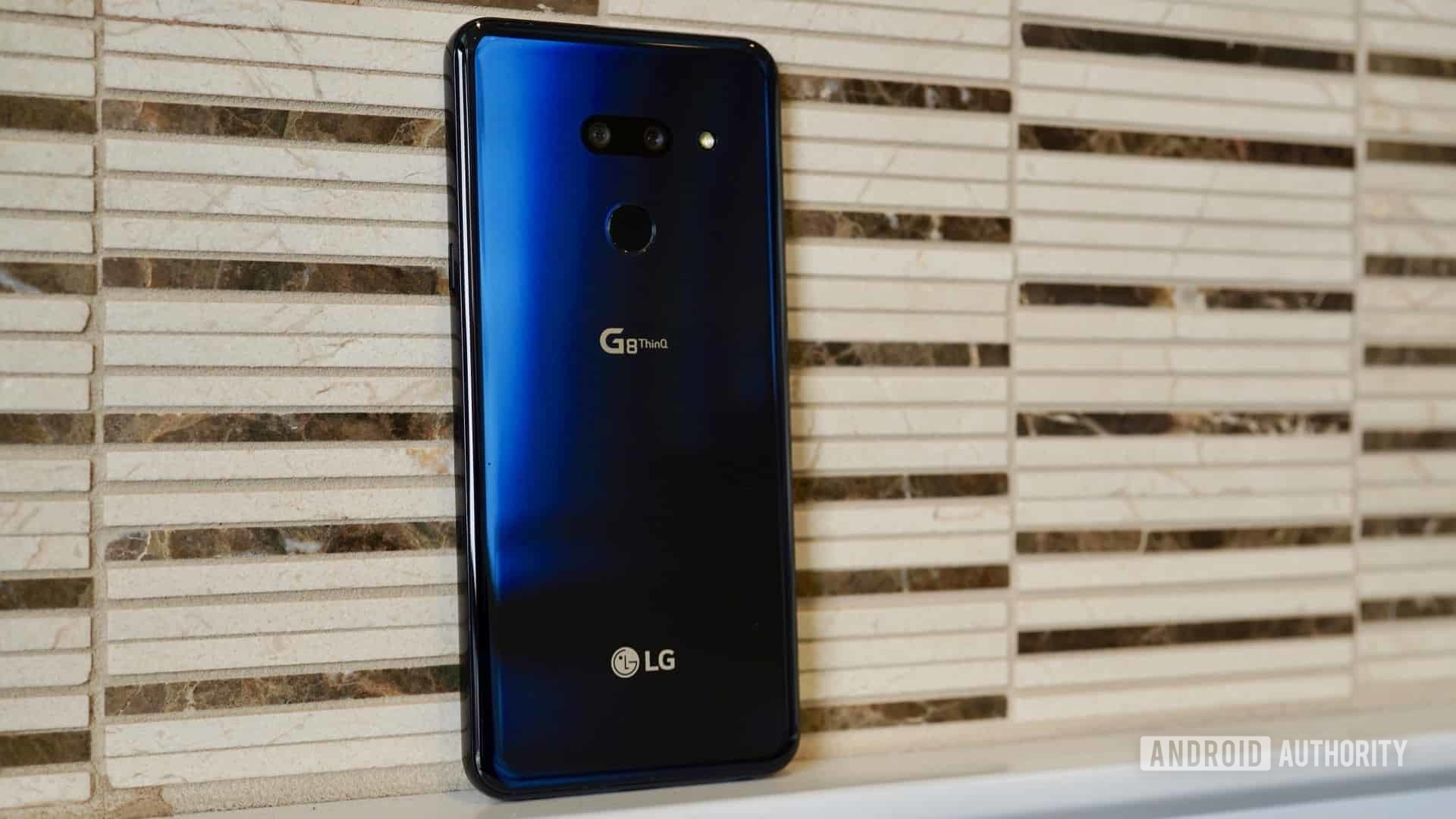
The result is two-fold. The phone is incredibly smooth and comfortable to use. There are no sharp edges to catch your skin or get caught in your pocket liner. However, the G8 is also among the most slippery devices I’ve ever held. It’s like walking around with a wet bar of soap. Sure, it’s smooth, but it’ll jump from your grasp with the slightest provocation.
The LG G8 is a great size. The dimensions of the phone make it easier to clutch than larger phones like the S10 Plus or Pixel 3 XL. LG kept the phone’s waist narrow, which does wonders for usability. If you’re skeptical about today’s largest devices, the G8 finds the right comfort zone.
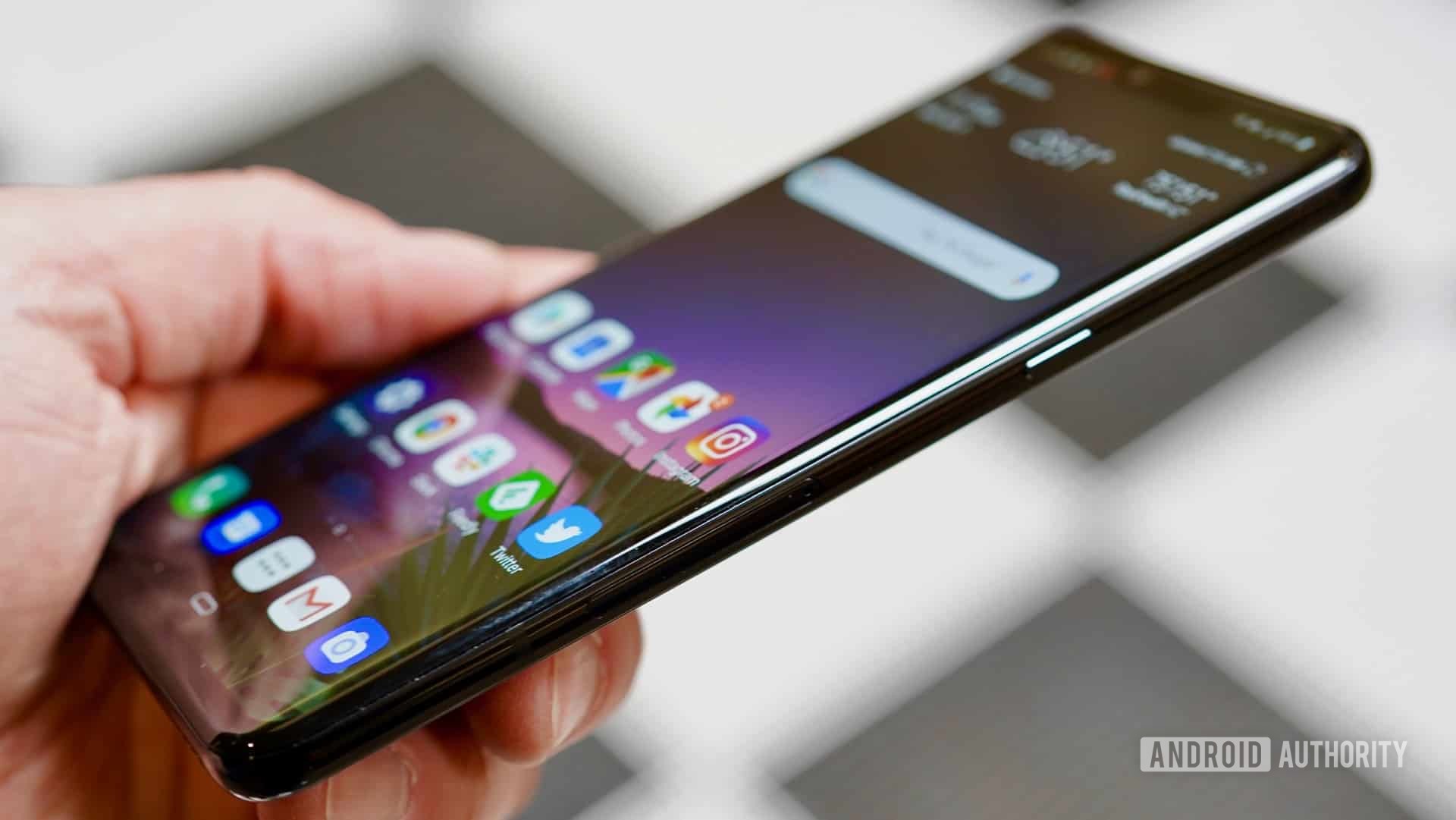
Everything about the phone’s basic hardware works perfectly. The screen lock button on the right and the volume and Assistant shortcuts keys on the left all deliver excellent action. The headphone jack, USB port, and speaker are all on the bottom edge where they belong, and the SIM tray is accessible via pin tool on the right.
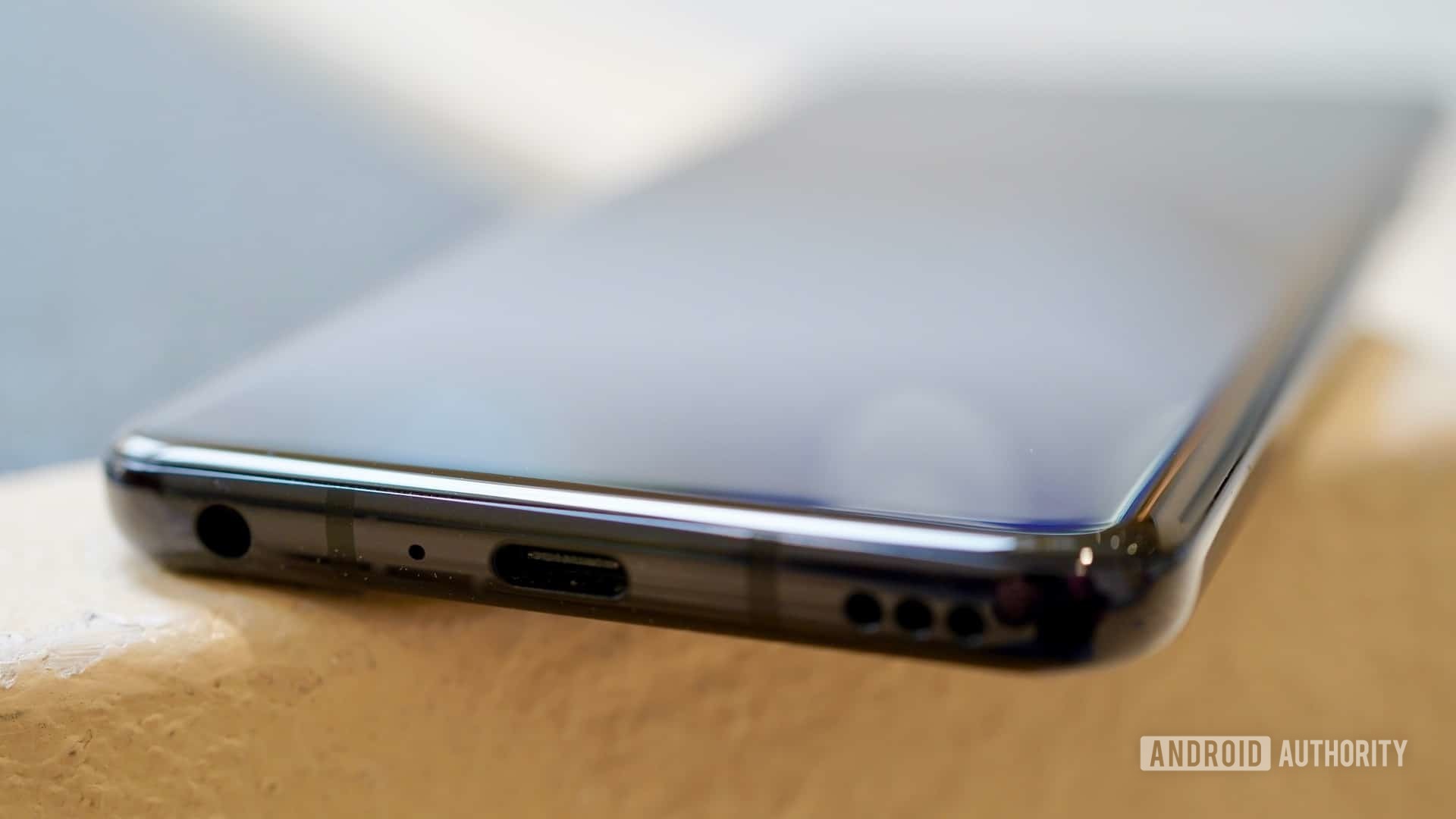
LG revised the design of its camera module and it’s much better. Where the G7 had a raised, vertical module, the G8 now has a flush, horizontal module. The flush module means the entire rear surface is smooth, with the exception of the indentation for the fingerprint reader.
The fingerprint reader is just where your finger expects to find it on the rear of the phone. Like most conventional readers, it is simple to train and store multiple prints.
Jimmy and I agree the reader is a bit slow. It works, but you have to hold your finger there just a beat longer than you’d want or expect. It could be faster, that’s all.
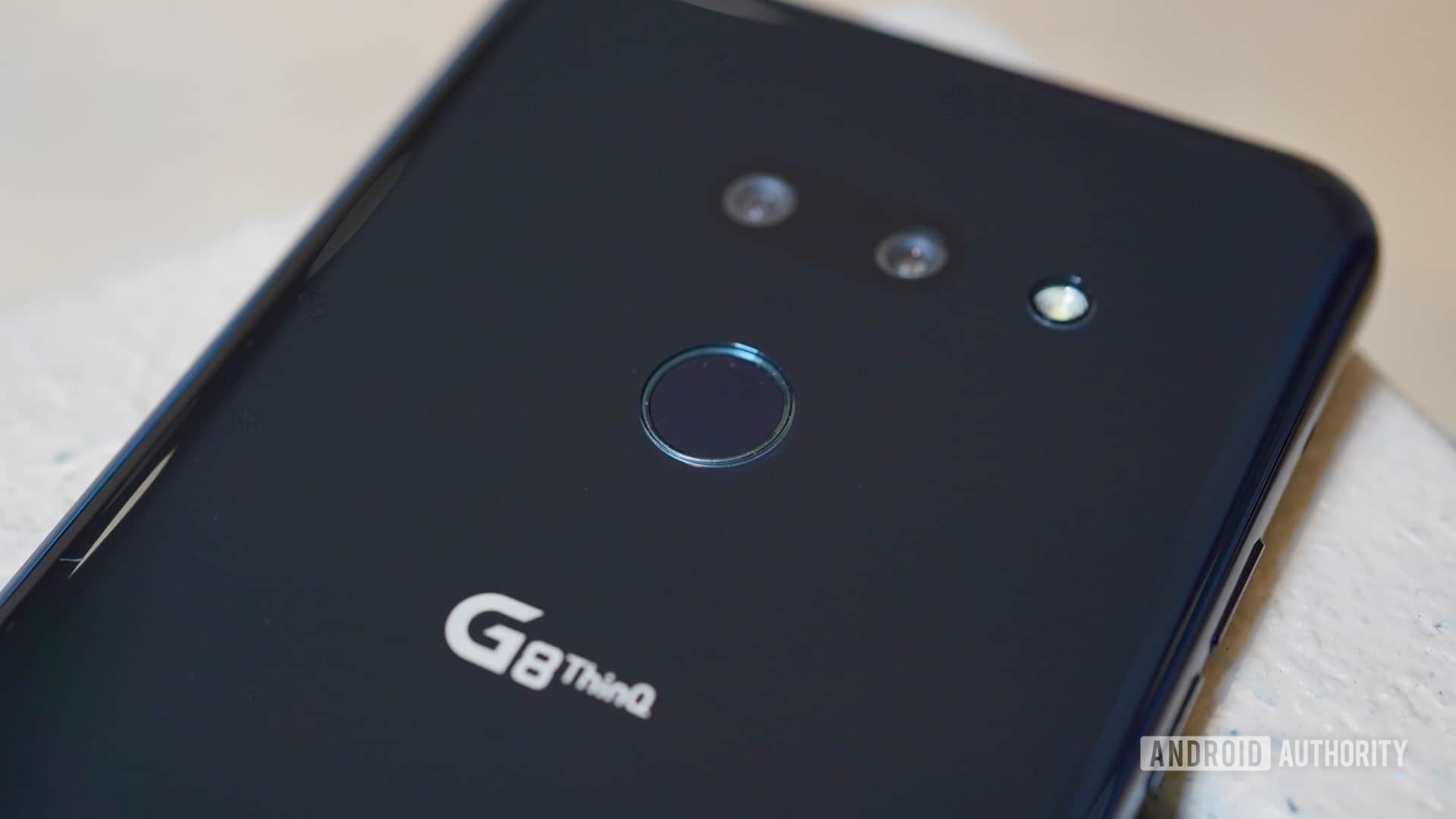
Corning’s Gorilla Glass 6 gives the G8 a tougher exterior. LG says the phone is certified to MIL-STD 810G for abuse, but I’m not about to throw it down some concrete stairs to test that. I did, however, dunk the phone in some water and, as expected, the IP68 rating means the phone is water resistant to 1.5 meters for up to 30 minutes. Accidents around shallow bodies of water shouldn’t be a death sentence for the G8.
The G8 boasts MIL-STD 810G and IP68.
The phone come in Carmine Red, Aurora Black, and New Morocco Blue. Our review unit is black.
Overall, the LG G8 ThinQ’s design is fine.
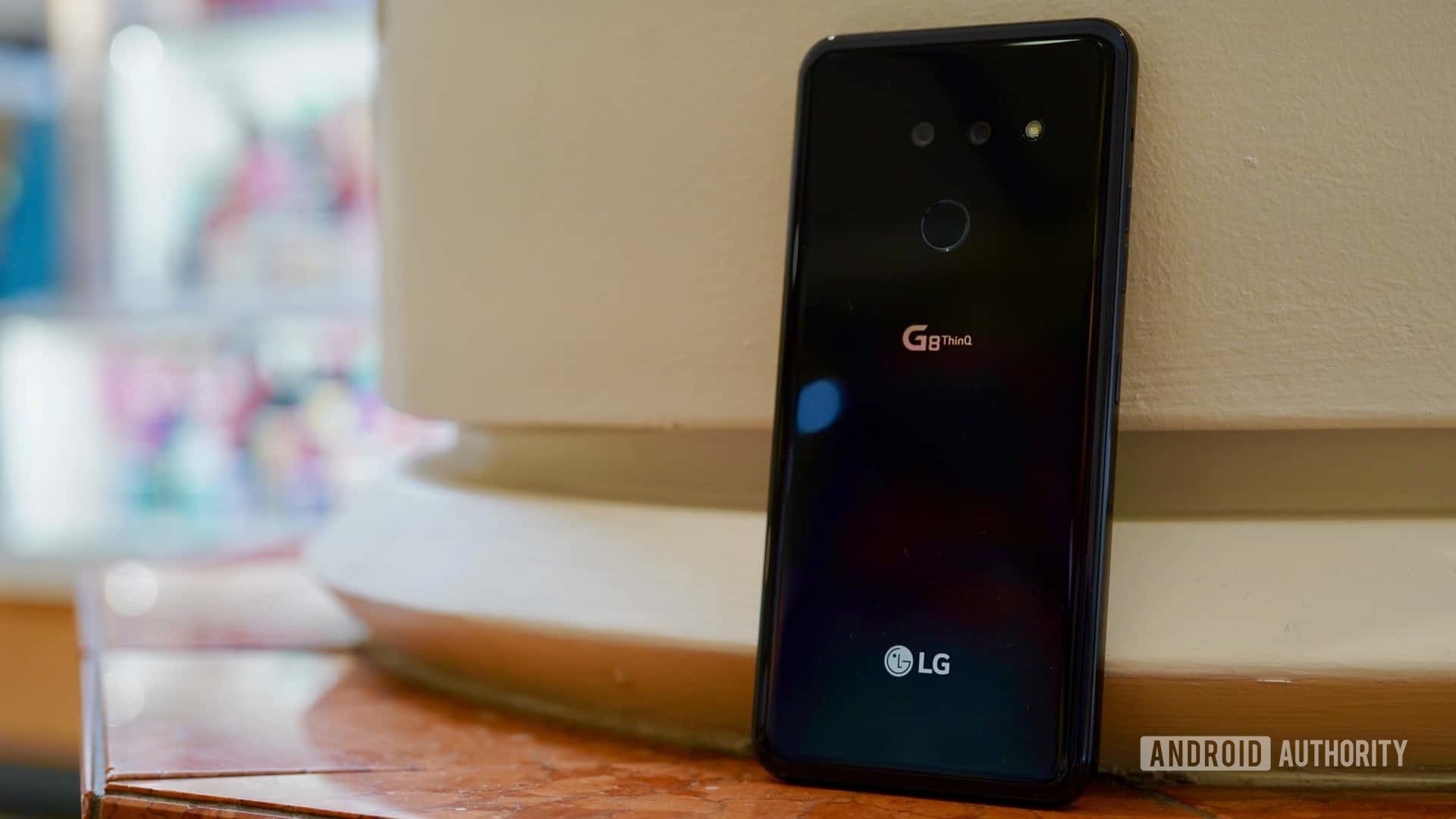
Display
- 6.1-inch Quad HD+ OLED FullVision
- 3,120 x 1,440 resolution, with 564ppi
- 19.5:9 aspect ratio
- Notch
LG Display continues to make excellent screens for its mobile phones. The G8’s screen is quite impressive. It carries over the basic specs from the G7, with HDR10 for even richer colors and deeper contrast. Colors look lush, blacks look inky, and the overall cast is spot on. It doesn’t shift blue or yellow, and viewing angles are excellent. In short, the screen is gorgeous.
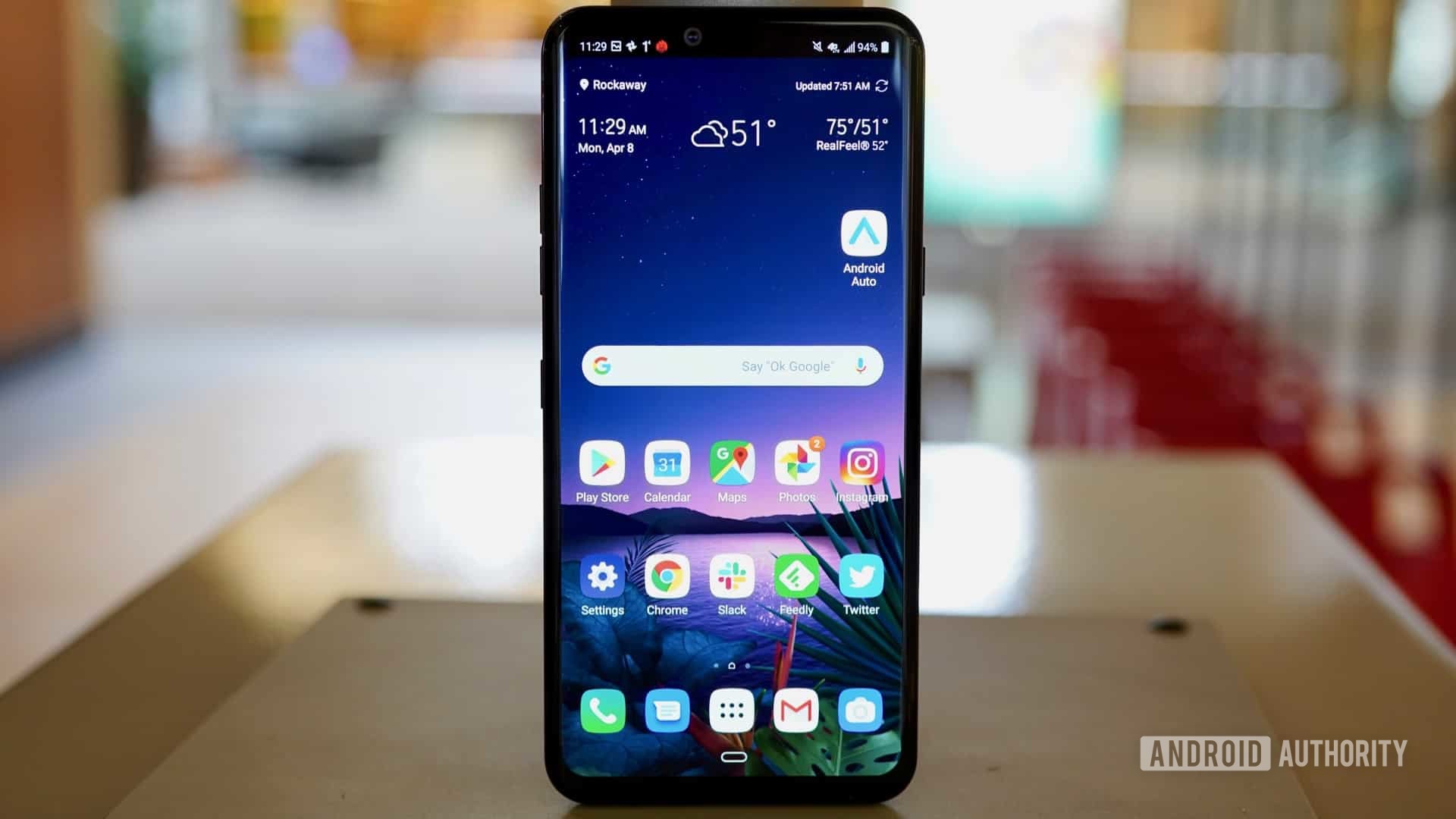
The OLED pumps out a solid amount of light. I was pleased with the screen’s brightness while indoors and out. I took it for a walk on a sunny afternoon and had no trouble using the camera or reading the menu screens.
You can’t ask for many more pixels than the G8 has. LG crammed ~4.49 million of them into the display, allowing the G8 to reveal the finest detail in the darkest content. Speaking of content, HDR movies from Netflix look phenomenal on the G8. I relished rewatching parts of Avengers: Infinity War ahead of Endgame’s imminent release.
You can control whether or not the notch is visible.
Yes, the G8 has a notch — not a teardrop or a hole punch — with a traditional, boat-like shape to it. You can control whether or not the notch is visible. LG calls this the “new Second Screen.” I like setting the notch wings to black so all I see is the status bar.
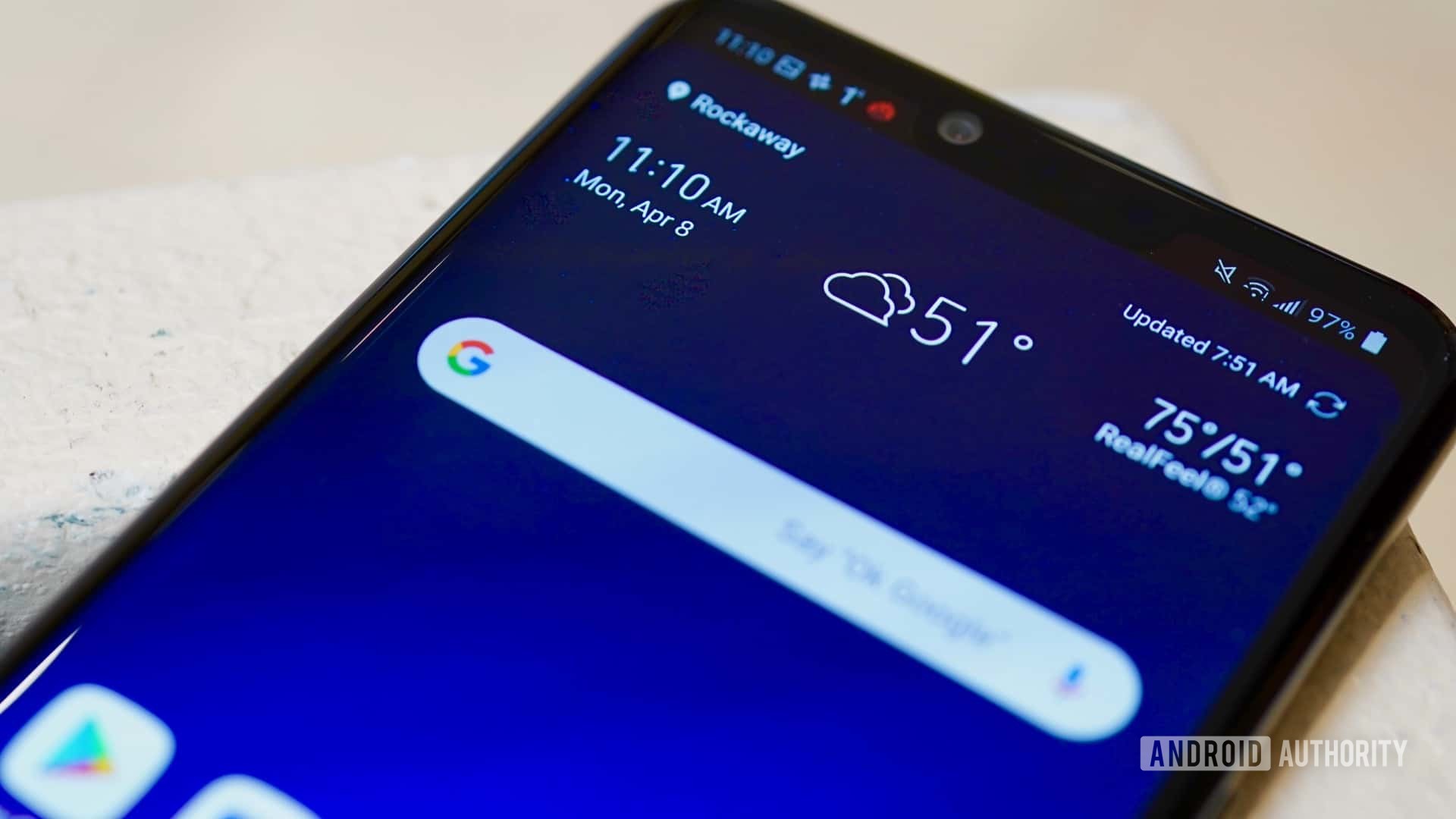
LG stuck the front-facing camera, time-of-flight camera, and IR sensor in the space between the notch wings. You won’t see a slit for the earpiece speaker because there isn’t one. The screen itself vibrates to create sound for calls and media (more on that later).
As per the norm, you have control over a wide range of display functions, such as resolution, color saturation, blue light, night mode, and so on.
On the whole, the screen is about all you can ask for from a modern smartphone.
Performance
- Snapdragon 855 SoC
- 2.8GHz octa-core, 7nm process
- 6GB RAM
- 128GB storage
Qualcomm’s Snapdragon 855, its premiere system-on-a-chip, delivers huge results in performance. The phone may have 6GB of RAM, where some competitors pack 8GB, but the LG G8 still ran smoothly over the 10-day review period. I didn’t run into a single hiccup, hangup, or hindrance. Screen transitions are smooth (if not overwrought with animations sometimes), apps open in a blink, and the phone never made me wait.
On the benchmark tests, the G8 scored well. It posted 5,627 on 3DMark Sling Shot Extreme (OpenGL ES 3.1), which put it ahead of 99 percent of competing phones. AnTuTu scores looked good. The main score was 118,730 (CPU), which defeated 88 percent of competing phones. Last, the G8 scored 10,788 and 3,447 on the multi-core and single-core Geekbench tests, respectively. These numbers put the G8 pretty much on par with the Galaxy S10, which has the same Snapdragon 855, but 8GB of RAM.
Battery
-
- 3,500mAh Lithium ion
- Qualcomm Quick Charge 3.0
- Qi wireless charging
Battery performance in the mid-sized flagship segment is remarkably consistent. Like many competitors, the LG G8 ThinQ pushes through more than a full day of battery life — at least when used somewhat conservatively. Jimmy and I both found when the screen is set to Full HD+ resolution (rather than the native Quad HD+) the G8 sails from morning to midnight no sweat.
The G8 charges rapidly.
If you choose to keep the resolution set to its highest level, the G8 struggles to make it to the end of the day. Does lowering the resolution make the screen look bad? No, not at all. Your eyes can hardly tell the difference between Full HD and Quad HD anyway.
The G8’s 3,500mAh battery is significantly larger than the 3,000mAh power cell on the G7. Honestly, I was hoping it would deliver more. LG offers plenty of tools for managing battery life, such as power saver mode. These various modes adjust certain behaviors, such as which radios are on, to conserve power.
With QuickCharge 3.0 on board, the G8 charges rapidly. LG packed one of its FastCharge chargers in the box. The G8 juiced up from 50 percent to 90 percent in less than 30 minutes.
The phone also supports Qi wireless charging, meaning it is compatible with most of the wireless chargers and accessories sold today.
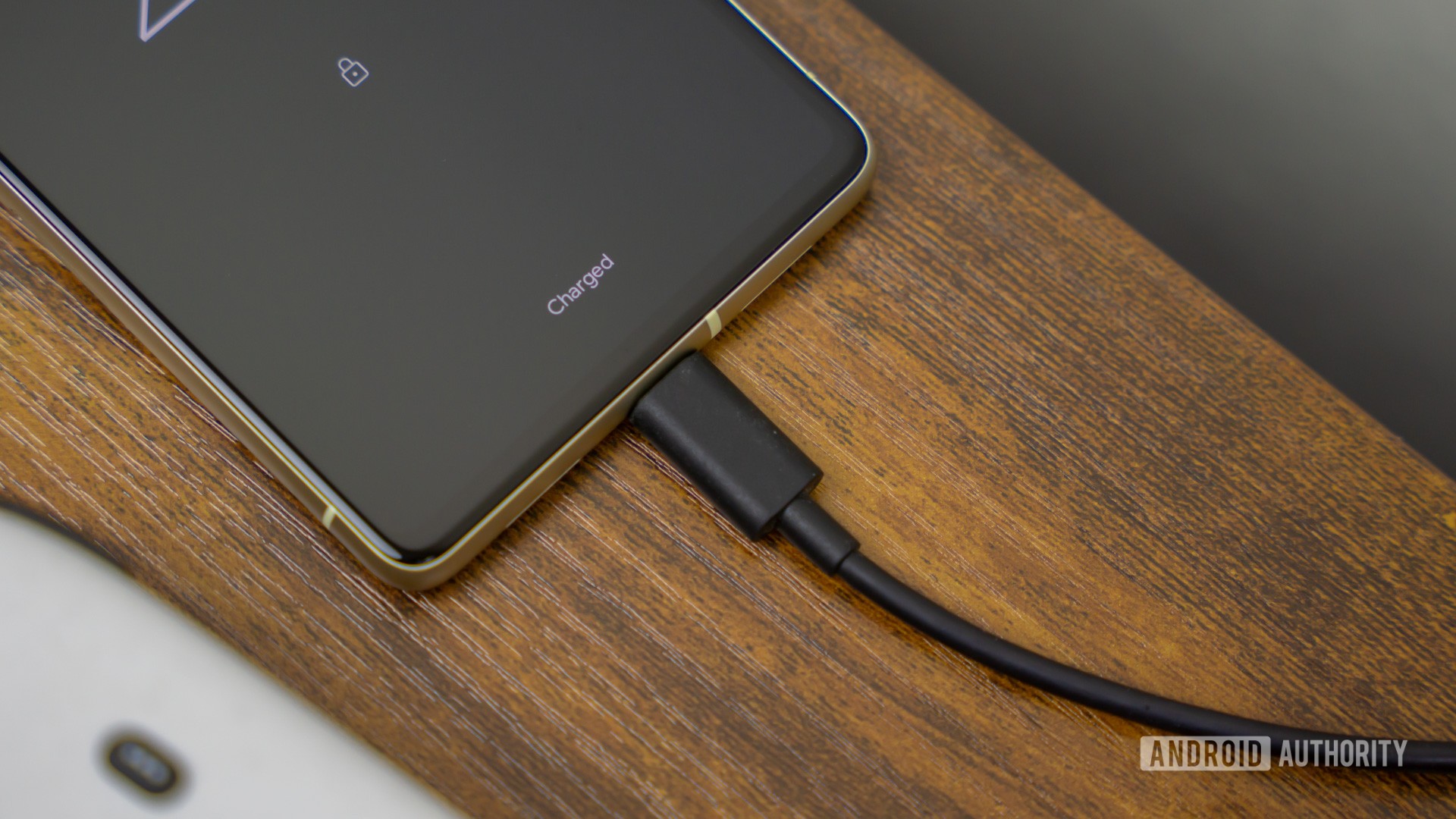
Camera
- Rear cameras:
- 16MP wide-angle lens (ƒ1.9 aperture/ 1.0μm pixels/ 107 degree field of view)
- 12MP standard lens (ƒ1.5 aperture/ 1.4μm pixels/ 78 degree field of view)
- Front camera:
- 8MP standard lens (ƒ1.7 aperture/ 1.22μm pixels/ 80 degree field of view)
- Z camera (time-of-flight (ToF))
Competition to create compelling cameras is fierce. Each manufacturer has taken a slightly different approach to their cameras, and LG is no different. Like the G7, the G8 features two rear cameras, one normal and one wide-angle. If you’re wondering why the G8 doesn’t have three rear cameras like the Galaxy S10 and P30 Pro, it’s because LG has decided to reserve the three-camera setup exclusively for its V series phones.
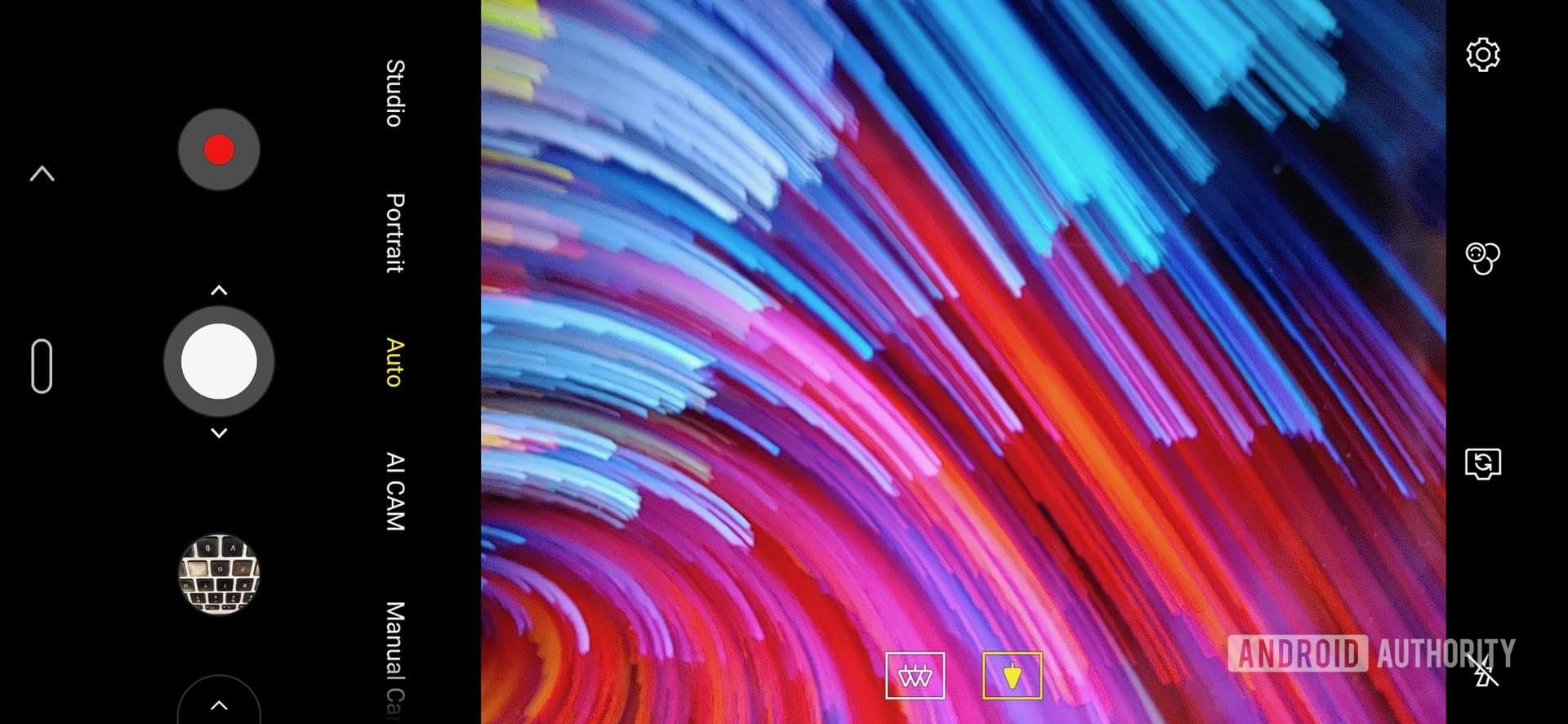
This year LG upped the ante by adding a time-of-flight (ToF) camera to the front, which lets the G8 do some things competing phones can’t — Hand ID and Air Motion (more on those in a bit).
Let’s start with the app. LG’s camera application follows what has become a fairly standard setup across flagships. The viewfinder is flanked by quick controls on the left (flash, filters, settings) and the shutter buttons and mode selector on the right. A small toggle at the top of the screen lets you jump between the two cameras for regular and wide-angle shots. The app runs quickly and opens with a fast double press of the down volume button.
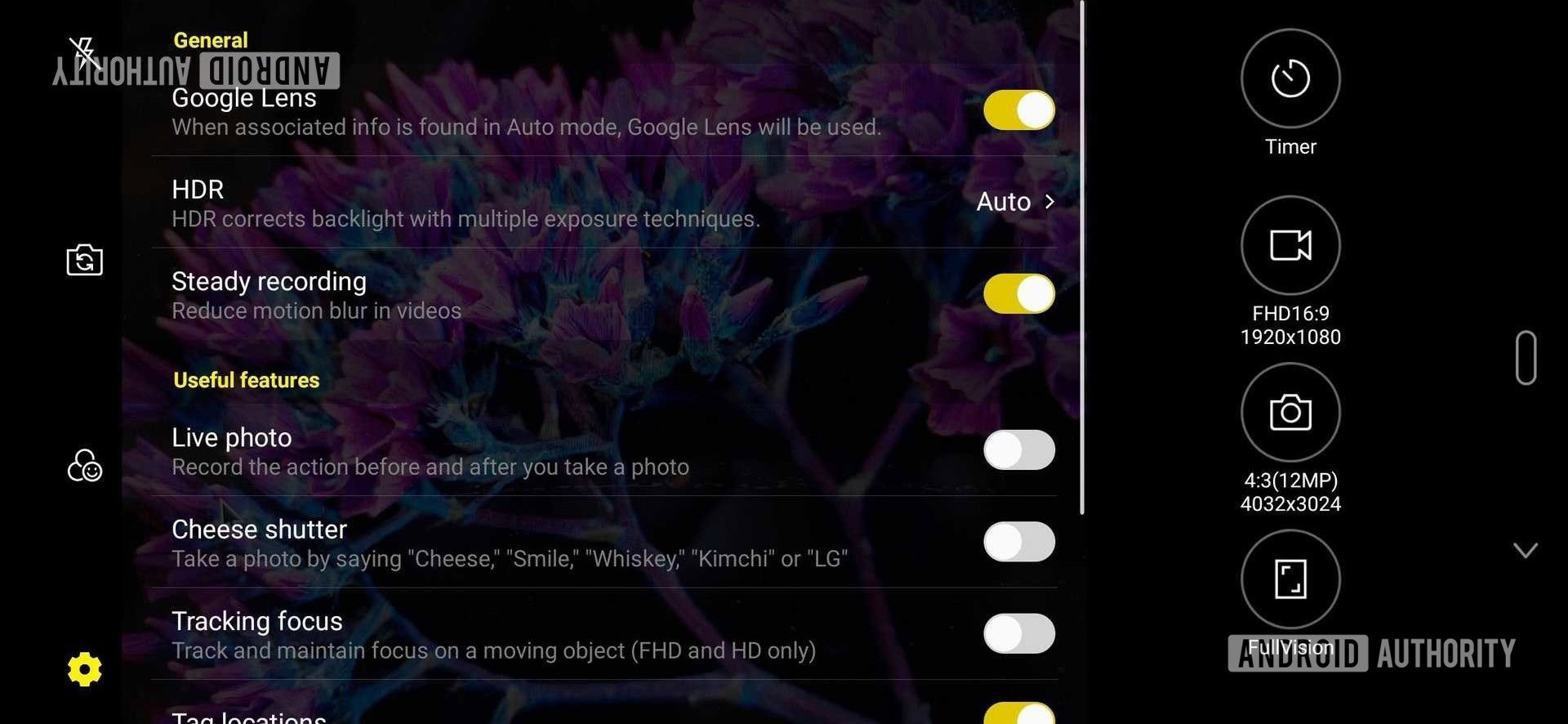
One usability foible bugs me. Many devices let you change modes by swiping the entire viewfinder in one direction or another. On the G8, swiping the viewfinder in any direction (side to side or up and down) flips to the selfie camera. If you want to access portrait mode, manual mode, and the others you have to actually tap the words in the ribbon running alongside the shutter buttons. There does not appear to be a way to change this.
Photo results are all over the place.
Shooting modes accessible from the main screen include studio, portrait, auto, AI cam, and manual. You have to tap the “more” button to access slow motion, cine-shot, manual video, cine-video, panorama, food, night view, AR stickers, and YouTube live. Most of these are old-hat at this point and fairly easy to use. Your mileage with each will vary.
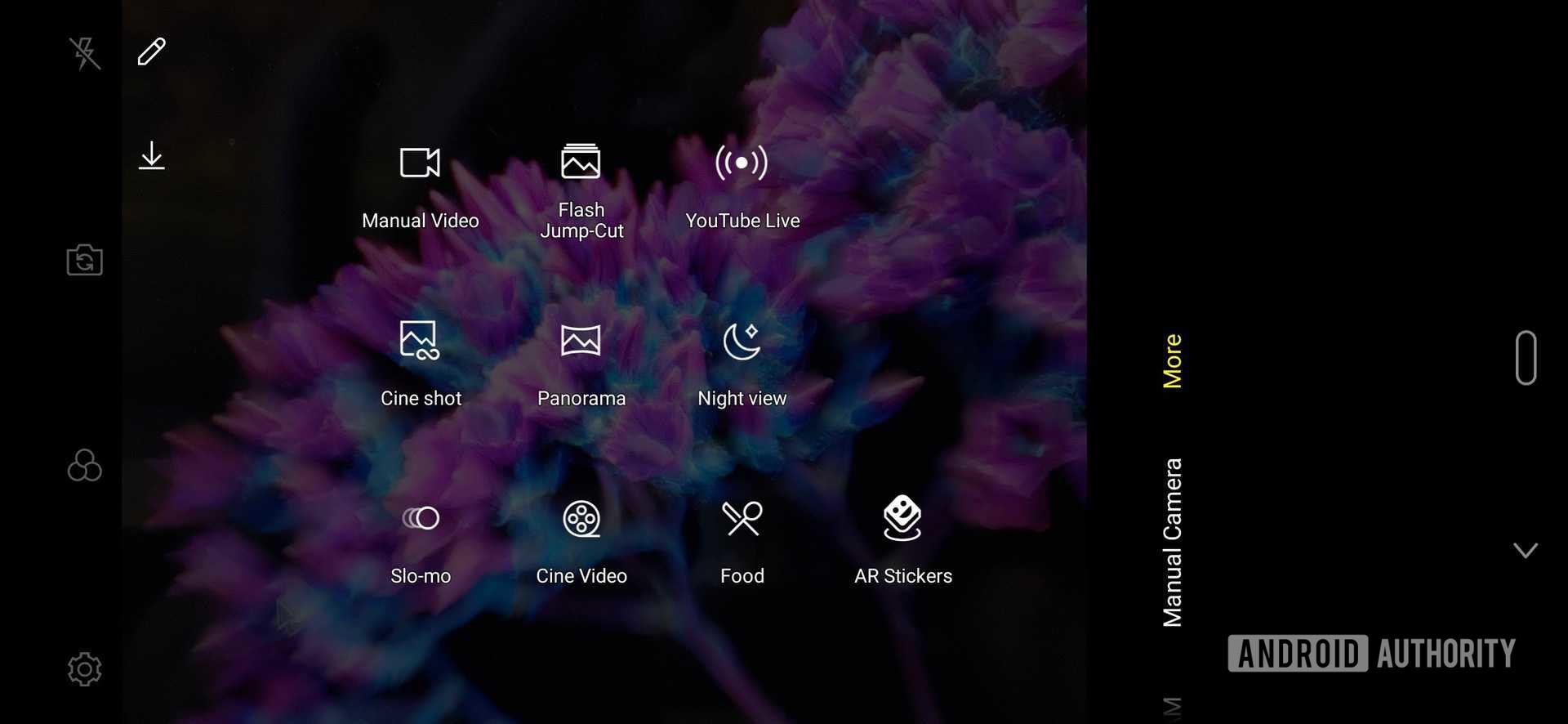
Photo results are all over the place. Some are perfect with respect to color, exposure, and sharpness. Others fail at all three. Noise reduction is too aggressive throughout, and contrast is hit or miss. Results vary even when you switch to AI cam or manual mode.
If you take a gander at the girl below, you’ll see decent edge detection in portrait mode. Compare that to Jimmy’s mug and it’s gasp-inducingly bad. Edge detection in the tree with yellow stripes is fairly decent, as is the photo with the flags. These were all taken in portrait mode.
Then there’s exposure. Many of the outdoor shots are overblown, resulting in lost detail. You can see this in the river and rock shots. Detail is also lost thanks to poor contrast control and inconsistent HDR.

The noise reduction is just too much throughout — except for when you actually want it. In the night-time church shots below, there’s an insane amount of noise and grain in the sky. These were difficult scenes, but the G8’s night mode is laughable compared to the Google Pixel 3 or HUAWEI P30 Pro, which can basically see in the dark.

To my eyes, many of the shots look flat, with poor color saturation. None of them floored me, and that’s a shame. The LG G8 performs better than your average $200 – $400 mid-ranger, but it just doesn’t reach the quality offered by the S10, P30 Pro, or Pixel 3.
You can find full resolution samples of the photos here.
As for video, you can capture footage in myriad aspect ratios and resolutions. The G8 offers 16:9 in HD, Full HD 30fps, Full HD at 60fps, 4K, and 4K at 60fps, as well as 18.9:9 in HD and Full HD.
Results generally fared better than what I saw from the camera. The G8 was quicker to respond to changes in lighting, and delivered accurate white balance and color. Focus was soft at times, and noise reduction wasn’t overly aggressive.
Then there’s Portrait Video. The G8 is among the first phones that can shoot video with background blur. Let’s just say it is a work in progress. Results are all over the map. The issue is edge detection, which never seems accurate. This is particularly a problem when the subject is moving.
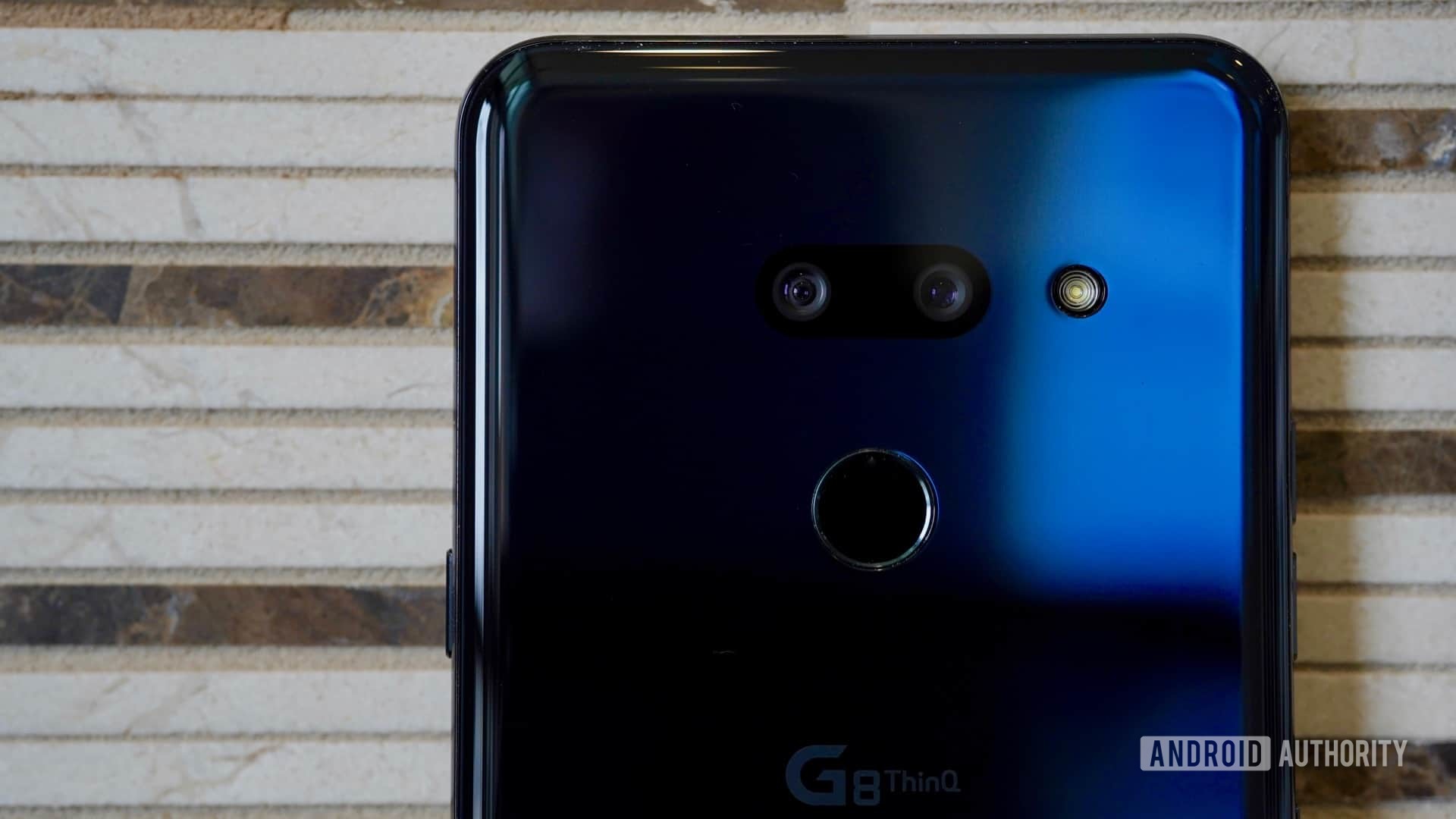
The two big features LG is pitching on the G8 are Hand ID and Air Motion, both of which are powered by the ToF camera on the front. Now, I totally dig when companies try something new to set their product apart, but it has to work and it should make my life better.
Hand ID and Air Motion don’t make my life better. They make me look and feel like a fool.
Hand ID
The G8 ThinQ can read your blood. More specifically, the ToF camera and infrared sensor work together to map out the veins in your palm. This map is unique and cannot be spoofed or faked. It’s really secure James Bond-like stuff. Training Hand ID takes patience. You have to start with your hand about a foot over the phone and slowly move it down toward the top edge, which is where the ToF and IR sensors are. It sort of feels like you’re trying to slap a bug in slow motion.
You unlock the G8 by repeating this slow motion approach with your palm. Start about six inches above the phone and slowly move toward the top edge until you’re about four inches away, then hold. You’ll see a yellow light frame the bottom of the display and work its way upward. If it turns green, congrats, you’ve unlocked the G8 with your hand. If it stays yellow, you’ve failed.
Expect to see a lot of yellow. This feature worked successfully perhaps 20 percent of the time and it takes forever. Also, the people sitting next to me at Starbucks looked at me like I was insane. The fingerprint reader is far faster and more reliable, as is Face ID.
Air Motion
You can control the LG G8 without touching the screen. When the device is unlocked, Air Motion offers a few shortcuts, using a similar process to Hand ID. Just hold your hand over the sensor for a second or so until the G8 sees it and turns on the Air Motion menu. It’s obvious, because a light flickers on near the notch. You then have to draw your hand back and form a claw with your fingers. Air Motion relies on seeing your fingertips to work. Hold your clawed hand over the sensor to interact with the shortcuts.
Air Motion boils down to two options, one to the left and one to the right. You turn your clawed fingers in one direction or the other to select which you want. These options are dependent on the context. When an alarm or timer goes off or a call comes in, you can silence the alarm or answer the call with Air Motion.
On the home screen, you can set the shortcuts to open media apps like music and YouTube. When you’re in a media app, you can even control the volume of playback by rotating your fingers in a circular motion like you’re dialing a massive volume knob.
Air Motion also lets you capture a screenshot by pinching your fingers together, basically making a snake with your hand. Seriously, don’t do this in public.
Hand ID and Air Motion don't make my life better.
I like LG’s ideas here, but the execution just isn’t there. Everything about Hand ID and Air Motion is too slow and too unreliable. It’s much faster and easier to interact with the phone directly as you normally would, even when your hands are wet or messy. Remember, the phone is water resistant and you can rinse it off if necessary.
Audio
- 3.5mm headphone jack
- Bluetooth 5 with aptX HD
- Stereo speakers
- FM radio
If anything should set the G8 apart, it’s the audio experience. LG’s flagship phones go above and beyond to entice audiophiles everywhere.
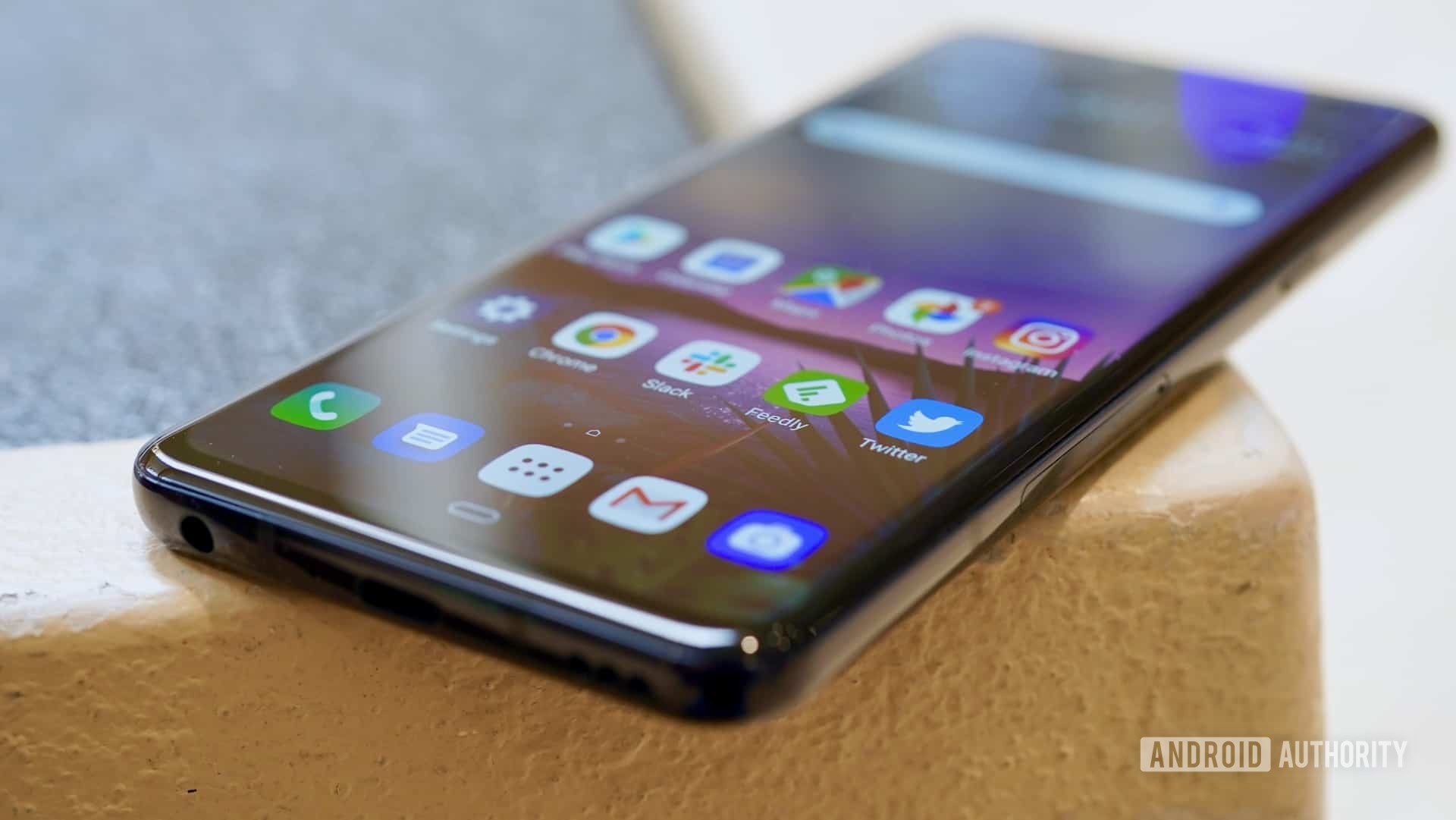
As mentioned earlier, the G8 doesn’t have a traditional earpiece speaker. Instead, it boasts a — wait for it — “Crystal Sound OLED.” Fancy, right? The phone’s OLED display itself serves as the speaker diaphragm. An exciter behind the glass causes it to vibrate in such a way that the display emits the sound. Surprisingly, it works. Phone calls sound quite clear and I found them easy to hear even in loud spaces.
When watching video, the Crystal Sound OLED works in concert with the bottom-firing speaker to create two-channel stereo sound. I wouldn’t call it immersive, but it sounds just fine when you’re jamming to some Spotify or watching a short YouTube clip.
Things get much better if you choose to plug in some traditional wired headphones (and this goes double if you have high-quality headphones). The G8 supports a 32-bit HiFi Quad DAC and features a High Quality DTS:X 3D Sound System. These are specific to the 3.5mm headphone jack. The DAC can up-sample most audio files to improve their fidelity. Moreover, it includes presets, user-adjustable controls for sound balance, and filters to clean up your streamed music. The DTS:X is meant to improve the movie experience.
Do these jargony components actually do what LG claims? I consider myself an audiophile and I was impressed. I hooked up my best wired headphones and did some A/B testing between the G8 and the S10, which also has a headphone jack. When playing the same music (same bitrate, same connection), the G8 clearly sounded better. Not by much, but still better. The difference was even clearer when I hooked the phones up to my home theater. Snippets of Star Wars: The Last Jedi sounded bombastic and huge via the G8, perhaps even cinematic.
Movies sound bombastic, perhaps even cinematic.
On the wireless front, the G8 packs Bluetooth 5 with aptX HD. This delivers just about the best quality you can expect over wireless headphones these days. I was pleased with the sound reproduced by the G8’s Bluetooth radio.
Software
- Android 9 Pie
The G8 runs Android 9 Pie from Google, along with LG’s user interface skin. The UX feels natural in some ways and heavy-handed in others. Naturally, you can tweak the hell out of it.
I like that you can opt between a home screen with or without an app drawer, whether your Google Feed appears as the left-most home screen, and whether the settings menu is arranged in tabs or a list. If you’re at all familiar with Android, you’ll find plenty of familiar behaviors.
The dedicated Google Assistant button has two functions. A single press launches Assistant, and a double press shows your info feed, much like what you see on a Pixel phone resting on Google’s Pixel Stand.
As always, LG lets you configure your own set of taps to wake or unlock the screen, install themes, and rearrange the app drawer. One interesting bug: when you move or delete apps from the app drawer, the drawer doesn’t automatically fill in the blank space. Moreover, freshly downloaded apps don’t slot into place alphabetically (if that’s how you sort them), but instead show up at the end of the list. In other words, it takes just a bit more work to manage the app drawer than it should.
We feel it’s important to note LG does not have a good track record for software updates. The G7 and V35 have yet to receive Android 9 Pie, even though comparable phones from Samsung, HUAWEI, Sony, and OnePlus have. (LG says the G7 update is only available in Korea, but is still on the way.) It’s hard to say if LG will ever get around to updating the G8 to Android Q, which will hit Pixel devices in just a few months.
Specs
| LG G8 ThinQ specs | LG G8s ThinQ specs | |
|---|---|---|
Display | LG G8 ThinQ specs 6.1-inch OLED FullVision 3,120 x 1,440 resolution 564ppi 19.5:9 aspect ratio | LG G8s ThinQ specs 6.2-inch OLED FullVision 2,248 x 1,080 resolution 18.7:9 aspect ratio |
SoC | LG G8 ThinQ specs Qualcomm Snapdragon 855 Mobile Platform | LG G8s ThinQ specs Qualcomm Snapdragon 855 Mobile Platform |
GPU | LG G8 ThinQ specs Adreno 640 | LG G8s ThinQ specs Adreno 640 |
RAM | LG G8 ThinQ specs 6GB | LG G8s ThinQ specs 6GB |
Storage | LG G8 ThinQ specs 128GB MicroSD expansion up to 2TB | LG G8s ThinQ specs 64/128GB |
Cameras | LG G8 ThinQ specs Rear cameras: 16MP wide-angle lens (ƒ1.9 aperture/ 1.0μm pixels/ 107˚ field-of-view) 12MP standard lens (ƒ1.5 aperture/ 1.4μm pixels/ 78˚ field-of-view) Front cameras: 8MP standard lens (ƒ1.7 aperture/ 1.22μm pixels/ 80˚ field-of-view) Z camera (time-of-flight (ToF)) | LG G8s ThinQ specs Rear cameras: 13MP wide-angle lens 12MP standard lens 12MP telephoto lens Front cameras: 8MP standard lens Z camera (time-of-flight (ToF)) |
Audio | LG G8 ThinQ specs Boombox Speaker + Crystal Sound OLED Stereo Speaker 32-bit Hi-Fi Quad DAC DTS:X 3D Surround Sound 3.5mm headphone jack | LG G8s ThinQ specs Stereo speakers |
Battery | LG G8 ThinQ specs 3,500mAh Qualcomm Quick Charge 3.0 | LG G8s ThinQ specs 3,550mAh Qualcomm Quick Charge 3.0 |
Durability | LG G8 ThinQ specs IP68 MIL-STD-810G | LG G8s ThinQ specs N/A |
Biometrics | LG G8 ThinQ specs Hand ID Face unlock Fingerprint sensor | LG G8s ThinQ specs Hand ID Face Unlock / Air Motion / Stereo Speakers |
Network | LG G8 ThinQ specs 3G 4G LTE-A | LG G8s ThinQ specs N/A |
Connectivity | LG G8 ThinQ specs Wi-Fi 802.11 a, b, g, n, ac Bluetooth 5.0 NFC USB Type-C (USB 3.1 compatible) | LG G8s ThinQ specs N/A |
Software | LG G8 ThinQ specs Android 9 Pie | LG G8s ThinQ specs N/A |
Dimensions and weight | LG G8 ThinQ specs 151.9 x 71.8 x 8.4mm 167g | LG G8s ThinQ specs N/A |
Colors | LG G8 ThinQ specs Carmine Red, New Aurora Black, New Platinum Gray | LG G8s ThinQ specs N/A |
Value for the money
LG and its carrier partners have an interesting tactic in place with respect to pricing. The core price of the phone, with 6GB RAM and 128GB storage, is $840. That’s what you’ll pay for the phone at AT&T and Verizon Wireless. Sprint sells the G8 for at $840 and T-Mobile has it for $620 (yes, really). Best Buy lists the phone at $650 for the unlocked model, while B&H is selling it for $850. That’s quite a range in pricing for the same device, and buy-one-get-one deals may change the equation after launch.
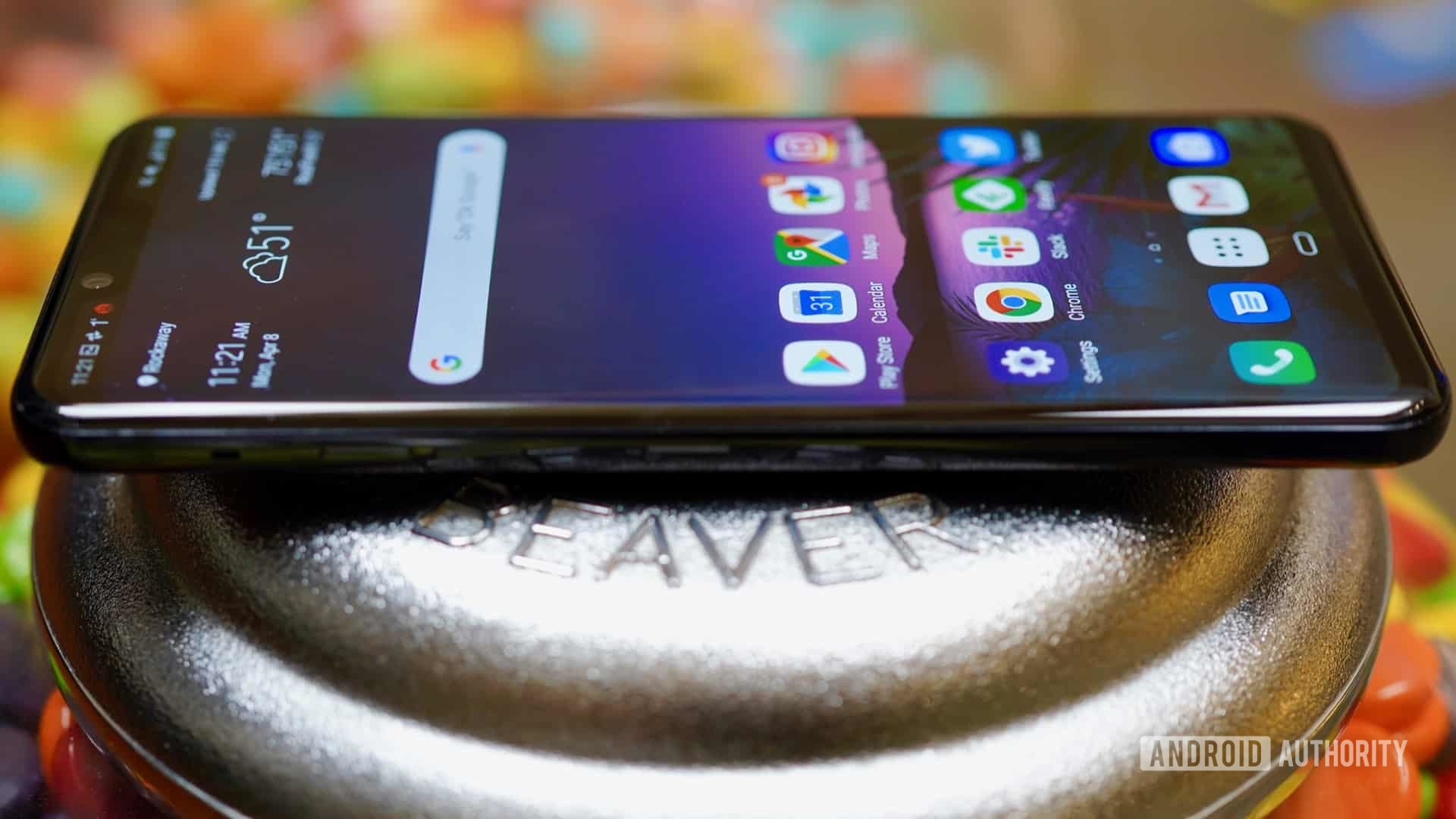
The raw $840 price point specifically targets the G8’s closest competitors, the $750 Galaxy S10e and the $900 Galaxy S10. The G8 is right in the middle. Surely LG did this on purpose. I think the $840 price might be reasonable for what the G8 delivers. It’s better than the S10e, but not quite as good as the S10 (or P30 Pro).
If you can score an unlocked model for $650, that’s an entirely different story. There’s no telling how long those prices will last, but at $650 the G8 is a fantastic value and a better option than the OnePlus 6T and Nokia 9 PureView.
LG G8 ThinQ review: The verdict
LG tries hard every year to outmatch Samsung and others, and every year it comes close but ultimately falls just short. This is the case again with the LG G8 ThinQ.
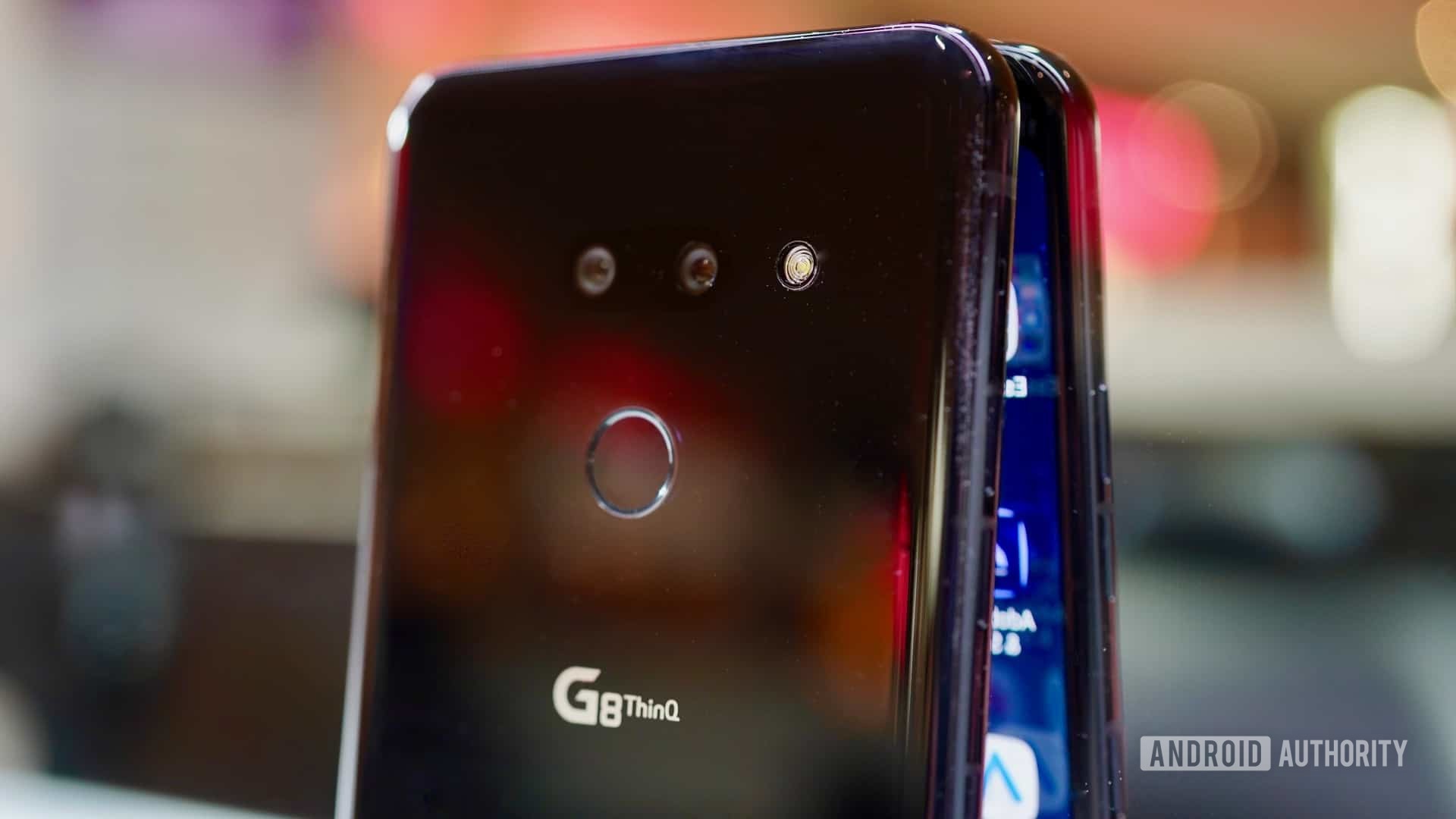
The hardware doesn’t inspire me much, though it employs new manufacturing techniques and rates high in quality. LG’s OLED display is lovely, and the phone delivers big time on core features like the headphone jack and high-end audio, as well as wireless charging, water resistance, expandable storage, and more.
LG’s software skin for Android is polished, but feels a little too heavy handed, with deep menus and fussy app drawer controls. Key apps like the camera run well and there are absolutely no performance issues.
Hand ID and Air Motion, the G8’s big gimmicks, are not the Jedi future we hoped for. I desperately want to control my phone by waving my hand around in front of it, but the G8 doesn’t get it quite right.
If you’re an LG fan who wants to spend less than $900 and likes the in-between size and form factor, the LG G8 ThinQ should work pretty well. You can find it at AT&T, Sprint, T-Mobile, and Verizon Wireless.
Want to hear more?
Interested in learning more about the LG G8 Thinq? Adam Doud, Jonathan Feist, and Eric Zeman share their thoughts in the latest episode of the Android Authority podcast. Listen to it below and subscribe!
Thank you for being part of our community. Read our Comment Policy before posting.